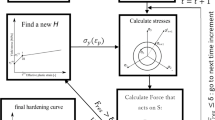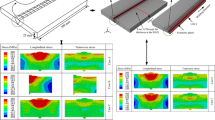Abstract
Stress wave propagation is a method in dynamic explicit solvers to determine the stresses in every element of solid materials. The necking in this method at a nearly random location within the sample in the numerical model, is due to the interaction between stress wave propagation speed and material deformations speed. However, a crucial aspect of this approach is the selection of appropriate material properties to produce accurate results for the timing of the necking. To achieve this, the numerical analysis models should be provided with the improved flow curve data using different hardening behaviors for post necking. This study examines various correction techniques and their impact on the time of the necking. It concludes that an explicit solver can precisely identify the necking only if an appropriate correction method is employed. Furthermore, the correction factor also affects the mechanism of strain propagation and the mode of failure after necking.









Similar content being viewed by others
References
Swift H W, J Mech Phys Solids 1 (1952) 1. https://doi.org/10.1016/0022-5096(52)90002-1
Marciniak Z, and Kuczyński K, Int J Mech Sci 9 (1967) 609. https://doi.org/10.1016/0020-7403(67)90066-5
Yasnikov I S, Vinogradov A, and Estrin Y, Scr Mater 76 (2014) 37. https://doi.org/10.1016/J.SCRIPTAMAT.2013.12.009
Armstrong R W, and Walley S M, Int Mater Rev. 53 (2013) 105. https://doi.org/10.1179/174328008X277795
Hwang J K, J Mater Sci 55 (2020) 8285. https://doi.org/10.1007/S10853-020-04477-X/FIGURES/5
ABAQUS/Explicit: User’s Manual - Google Books. https://books.google.com.tr/books/about/ABAQUS_Explicit.html?id=G30YAQAAMAAJ&redir_esc=y. Accessed 24 Jan 2023
Christopher J, and Choudhary B K, Mech Res Commun 94 (2018) 114. https://doi.org/10.1016/J.MECHRESCOM.2018.10.004
Macaulay M, Introduction Impact Eng (1987). https://doi.org/10.1007/978-94-009-3159-6
von Karman T, and Duwez P, J Appl Phys 21 (2004) 987. https://doi.org/10.1063/1.1699544
Bridgman P W, With Special Emphasis on the Effects of Hydrostatic Pressure (2013)
Yang S Y, and Tong W, Exp Mech 49 (2009) 317. https://doi.org/10.1007/S11340-009-9241-X/FIGURES/14
Majzoobi G H, Fariba F, Pipelzadeh M K, and Hardy S J, J Strain Anal Eng Des. 50 (2014) 125. https://doi.org/10.1177/0309324714555384
Scheider I, Brocks W, and Cornec A, J Eng Mater Technol 126 (2004) 70. https://doi.org/10.1115/1.1633573
Choung J M, and Cho S R, J Mech Sci Technol 22 (2008) 1039. https://doi.org/10.1007/S12206-008-0302-3/METRICS
Dizaji S A, and Paygozar B, in 19th Int. Conf. on Machine Design and Prod. Cappadocia, Turkey, (2022)
Björklund O, and Nilsson L, J Mater Process Technol 214 (2014) 1190. https://doi.org/10.1016/J.JMATPROTEC.2014.01.004
Author information
Authors and Affiliations
Corresponding author
Ethics declarations
Conflict of interests
The authors declare that they have no known competing financial interests or personal relationships that could have appeared to influence the work reported in this paper.
Additional information
Publisher's Note
Springer Nature remains neutral with regard to jurisdictional claims in published maps and institutional affiliations.
Rights and permissions
Springer Nature or its licensor (e.g. a society or other partner) holds exclusive rights to this article under a publishing agreement with the author(s) or other rightsholder(s); author self-archiving of the accepted manuscript version of this article is solely governed by the terms of such publishing agreement and applicable law.
About this article
Cite this article
Dizaji, S.A. Evaluation of Post Necking Behavior of Metals Using Stress Wave Propagation Technique. Trans Indian Inst Met 76, 3087–3094 (2023). https://doi.org/10.1007/s12666-023-03044-7
Received:
Accepted:
Published:
Issue Date:
DOI: https://doi.org/10.1007/s12666-023-03044-7




